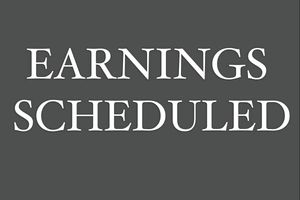Boot Barn Holdings, Inc. Common Stock (BOOT)
201.06
+7.02 (3.62%)
NYSE · Last Trade: Dec 3rd, 9:42 PM EST
Detailed Quote
| Previous Close | 194.04 |
|---|---|
| Open | 196.47 |
| Bid | 179.00 |
| Ask | 323.09 |
| Day's Range | 194.02 - 201.60 |
| 52 Week Range | 86.17 - 205.31 |
| Volume | 445,831 |
| Market Cap | 6.14B |
| PE Ratio (TTM) | 29.65 |
| EPS (TTM) | 6.8 |
| Dividend & Yield | N/A (N/A) |
| 1 Month Average Volume | 479,951 |
Chart
About Boot Barn Holdings, Inc. Common Stock (BOOT)
Boot Barn Holdings Inc is a leading retailer specializing in Western and work-related apparel, footwear, and accessories. The company offers a wide range of high-quality products catering to the lifestyle of those who live, work, and play in the Western United States. With a focus on providing a unique shopping experience, Boot Barn features both well-known national brands and its own private label merchandise. The company also emphasizes customer service and community engagement, making it a go-to destination for individuals seeking authentic Western wear and gear. Read More
News & Press Releases

Generating cash is essential for any business, but not all cash-rich companies are great investments.
Some produce plenty of cash but fail to allocate it effectively, leading to missed opportunities.
Via StockStory · November 25, 2025
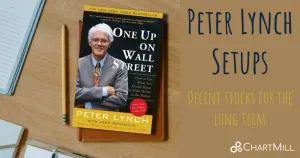
Boot Barn (BOOT) aligns with Peter Lynch's GARP strategy, showing strong earnings growth, a reasonable PEG ratio of 0.95, and a debt-free balance sheet.
Via Chartmill · November 22, 2025
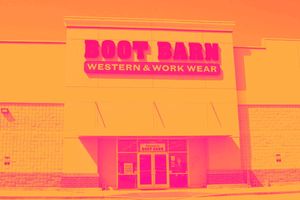
Shares of clothing and footwear retailer Boot Barn (NYSE:BOOT)
jumped 7.1% in the afternoon session after fellow apparel retailer Gap reported strong third-quarter sales and raised its full-year forecast, boosting investor sentiment across the retail sector. Gap announced that its net sales rose by 3% compared to the same period in the previous year, and its comparable sales grew by 5%. This positive performance from a major competitor suggested a healthy consumer spending environment, which likely increased investor confidence in other companies within the apparel market, such as Boot Barn.
Via StockStory · November 21, 2025
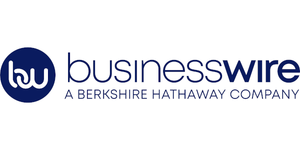
Boot Barn Holdings, Inc. (NYSE: BOOT) (“Boot Barn”), the nation’s leading western and work wear retailer, is proud to announce the grand opening of its 500th store this month. This milestone arrives alongside several new store openings across the nation, including stores in Killeen, TX, East Peoria, IL, Phoenix, AZ, Deptford, NJ, Indio, CA, Chandler, AZ, and a meaningful return to Huntington Beach, CA, where the very first Boot Barn store opened its doors in 1978. From that single storefront, Boot Barn has grown its nationwide presence to span 49 states, reflecting both strong consumer demand for high-quality western and work wear and Boot Barn’s successful internal growth strategy in new markets.
By Boot Barn · Via Business Wire · November 21, 2025

Via Benzinga · November 12, 2025

Boot Barn (BOOT) combines strong profitability, high growth, and a debt-free balance sheet with a top technical rating and breakout chart setup.
Via Chartmill · November 11, 2025

Small-cap stocks in the Russell 2000 (^RUT) can be a goldmine for investors looking beyond the usual large-cap names.
But with less stability and fewer resources than their bigger counterparts, these companies face steeper challenges in scaling their businesses.
Via StockStory · November 6, 2025

Boot Barn’s Q3 results reflected broad-based strength across its business, with management attributing the performance to balanced growth in both physical and digital channels, as well as operational improvements. CEO John Hazen highlighted the impact of 64 new stores opened in the past year and an 8.4% rise in same-store sales, noting “broad-based growth across all major merchandise categories in stores and online.” Merchandise margin rate also improved, fueled by higher exclusive brand penetration and disciplined expense control. Management emphasized that these results were achieved despite ongoing macroeconomic uncertainty and evolving consumer sentiment.
Via StockStory · November 5, 2025

Retailers are overhauling their operations as technology redefines the shopping experience. Still, demand can be volatile as the industry is exposed to the ups and downs of consumer spending.
This has stirred some uncertainty lately as retail stocks have lagged the market over the past six months, posting a return of 12.5% compared to 20% for the S&P 500.
Via StockStory · November 4, 2025

BOOT BARN HOLDINGS INC exemplifies Peter Lynch's GARP strategy with strong earnings growth, high profitability, and minimal debt, trading at a reasonable PEG ratio.
Via Chartmill · November 1, 2025

Clothing and footwear retailer Boot Barn (NYSE:BOOT) beat Wall Street’s revenue expectations in Q3 CY2025, with sales up 18.7% year on year to $505.4 million. Guidance for next quarter’s revenue was optimistic at $694 million at the midpoint, 2.5% above analysts’ estimates. Its GAAP profit of $1.37 per share was 7.5% above analysts’ consensus estimates.
Via StockStory · October 30, 2025

Clothing and footwear retailer Boot Barn (NYSE:BOOT) reported Q3 CY2025 results beating Wall Street’s revenue expectations, with sales up 18.7% year on year to $505.4 million. Guidance for next quarter’s revenue was optimistic at $694 million at the midpoint, 2.5% above analysts’ estimates. Its GAAP profit of $1.37 per share was 7.5% above analysts’ consensus estimates.
Via StockStory · October 29, 2025

Boot Barn Holdings, Inc. (NYSE: BOOT) (the “Company”) today announced its financial results for the second fiscal quarter ended September 27, 2025. A Supplemental Financial Presentation is available at investor.bootbarn.com.
By Boot Barn · Via Business Wire · October 29, 2025
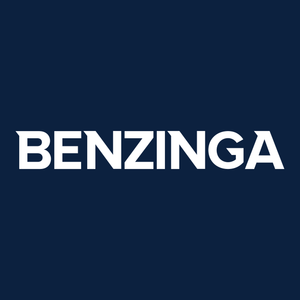
Via Benzinga · October 28, 2025
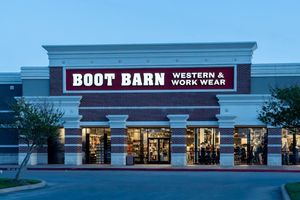
Via Benzinga · October 28, 2025

Clothing and footwear retailer Boot Barn (NYSE:BOOT)
will be reporting earnings this Wednesday after market hours. Here’s what investors should know.
Via StockStory · October 27, 2025

The S&P 500's Consumer Discretionary sector presented a fascinating dichotomy on October 23, 2025, with a standout performance from casino giant Las Vegas Sands (NYSE: LVS) masking an otherwise subdued day for the broader sector. While the overall index saw modest gains, the discretionary segment initially lagged, appearing in
Via MarketMinute · October 23, 2025

Boot Barn Holdings, Inc. (NYSE: BOOT) today announced that the company will release its financial results for the second quarter fiscal year 2026 ended September 27, 2025, after the market close on Wednesday, October 29, 2025. Management will host a conference call that afternoon (October 29, 2025) at 4:30 p.m. ET (1:30 p.m. PT) to discuss the financial results.
By Boot Barn · Via Business Wire · October 22, 2025

The past six months have been a windfall for Boot Barn’s shareholders. The company’s stock price has jumped 106%, hitting $191.96 per share. This was partly due to its solid quarterly results, and the run-up might have investors contemplating their next move.
Via StockStory · October 22, 2025

Volatility cuts both ways - while it creates opportunities, it also increases risk, making sharp declines just as likely as big gains.
This unpredictability can shake out even the most experienced investors.
Via StockStory · October 21, 2025

The past six months have been a windfall for Boot Barn’s shareholders. The company’s stock price has jumped 108%, hitting $184.99 per share. This was partly due to its solid quarterly results, and the performance may have investors wondering how to approach the situation.
Via StockStory · October 20, 2025

Boot Barn (BOOT) is a high-growth stock in a strong technical uptrend, meeting Mark Minervini's criteria with impressive earnings and sales momentum.
Via Chartmill · October 17, 2025

Boot Barn (BOOT) combines strong sales & earnings growth with a positive technical setup, offering a potential growth & momentum opportunity for investors.
Via Chartmill · October 11, 2025

